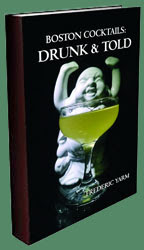A day and a half later on Wednesday afternoon, Greg sent me an email inviting me out to Westborough that evening to meet the distiller of Noyau de Poissy. The distiller was in the area doing a "Forgotten Cask" Cognac blending seminar where he would blend spirits from the 1890 to 1910. It sounded like an interesting proposition, and the rush hour drive to central Massachusetts was worth the chance of scoring a bottle of Noyau de Poissy. I had no clue what I was in store for.
The distiller was Alain Royer who I had just heard talk a few days before at the Armagnac seminar at Tales of the Cocktail. This blending class was not as open to the public as the Tales of the Cocktail one was, but it was an invite-only event for the Loch and K(e)y Society at Julio's Liquors. Usually, this private group is highly focused on whisk(e)y including trips to Kentucky to taste and chose Bourbon barrels for purchase and the like. This time, it was to have the honor of Alain Royer crafting a Cognac to their communal tastes, and two dozen participants enthusiastically showed up to participate.
The concept was that a barn full of forgotten casks of Cognacs from the late 19th and early 20th centuries had turned up. The Cognacs were from all across the region, and there was not enough of each vintage to put into big blends for the mass market. This is where Alain was brought into the project to use his superior skill in blending to allow the casks' contents to find their way into glasses somehow or other. Alain described his first moments in that barn as walking into a museum. He immediately began picking up demijohns and making an inventory.

For our blending exercise, there were three Cognacs -- one base and two aromatic or flavorful ones -- and we set about tasting them individually. This particular base was from 1902 after spending 35-40 years in a barrel, although it had been topped up over time until the late 1950s. When tasted straight, it was rather polished and not much of a conversation breaker. The second Cognac was from 1898. The tasting notes were that it was a warm, velvety spirit typical of turn of the century Cognacs and was filled with tangerine, plum, and Madeira touches. A little sure went a long way on the tongue. Indeed, it was too spicy to drink straight and was deemed a booster to add flavor to a blend. The third and final Cognac was from 1908 with an unknown number of years in oak casks; when a glass was swirled, the legs or tears fell down slowly which indicated a lot of concentration from aging. It was definitely the most funky of the three with descriptors of dampness, mushroom, fungal, caramel, and orange being mentioned. To the mouth, it was very spicy and acidic suggesting that the tannins were not in balance; however, it was seductive to the nose like a good Pinot Noir.
Royer began by filling his one liter graduated cylinder half way with the base. Since we already had a taste of this Cognac straight, he immediately added 200 mL of the second Cognac. After mixing the contents, the room was given a taste. Here, the nose gave most of the information and the mouth confirmed the flavor and the balance. With the addition, the blend went above the base and was given a push with the added richness of flavor. In fact, it had become better than either of the initial ingredients alone. The third pour was from the last Cognac. That 100 mL addition then donated flavors that resulted in a dark chocolate note with hints of mushroom and with less spice than the blend taste before.
What direction to take the last fifth of the batch? This is where Royer philosophized about the concept of contradiction and harmony. Blending was an art akin to balancing a teeter totter. To tame the blend, the room agreed with Alain that more base needed to be added which would cut down the proof and the concentration of harder spices on the mouth. The Cognac began to take a more plum and leathery taste to me. The consensus of the room was to add some more of the third spirit to bring back more of the aroma that was drowned out by the addition of more base. This brought the profile closer to where it was before. The aroma became a bit more floral and elegant with honeysuckle notes popping out at this stage.
With each successive addition of Cognac, we had a taste and the room was then voting on what the next 25 mL or 10 mL would be. The goal was to chase away the negative and bring back the positive in order to achieve the golden ratio. Somewhere around this point, I began to get skeptical and thought of it as an exercise of control in the creation of the final product more than a major change in it. A 10 mL addition was merely a percent of the total. This would seem like a lot if it was a novel constituent, but there was already well over a hundred milliliters of each component in there. I, however, was alone in this thought at my table, and perhaps the Society members had more refined noses and palates than I. It finally came down to the last 5 mL and the room could not come to a consensus. At this point, Alain divided up the blend in two bottles and added a bit more of the third Cognac (half or 2.5 mL was added) to one of them. After a four week maturation, the Society would have a chance to see which decision for this last step was the right one. Would a mere half percent difference in the contents of the final mix be discernible? Only time would tell.
Having been invited to the event without really understanding the big picture, I had to ask a few questions later about what was going on. In late August, there would be a taste of the mellowed blends, and the Society members would get to choose which one Alain should scale up and produce. This exclusive blend would yield around 36 bottles of Cognac, which after a month of aging would be ready for Christmas. The estimated cost for each bottle of "Forgotten Cask" was around $160.
Alas, there was no Crème de Noyau at the end of the rainbow, but the experience of watching a master blender at work was definitely an acceptable bait and switch.
 The 2017 collection of 855 drink recipes, bartender tributes, and essays on hospitality from CocktailVirgin's Frederic Yarm. Available at
The 2017 collection of 855 drink recipes, bartender tributes, and essays on hospitality from CocktailVirgin's Frederic Yarm. Available at  The 2012 collection of 505 drink recipes, techniques, and Boston bar recommendations from Frederic Yarm. Available at
The 2012 collection of 505 drink recipes, techniques, and Boston bar recommendations from Frederic Yarm. Available at 




1 comment:
You should join the Loch & Key, there are a lot of good events if you can make it out to the suburbs. There was a great Pierre Ferrand tasting back in December, and the owner of Julios Liquors has been working to get some of the harder to find cocktail ingredients.
Post a Comment